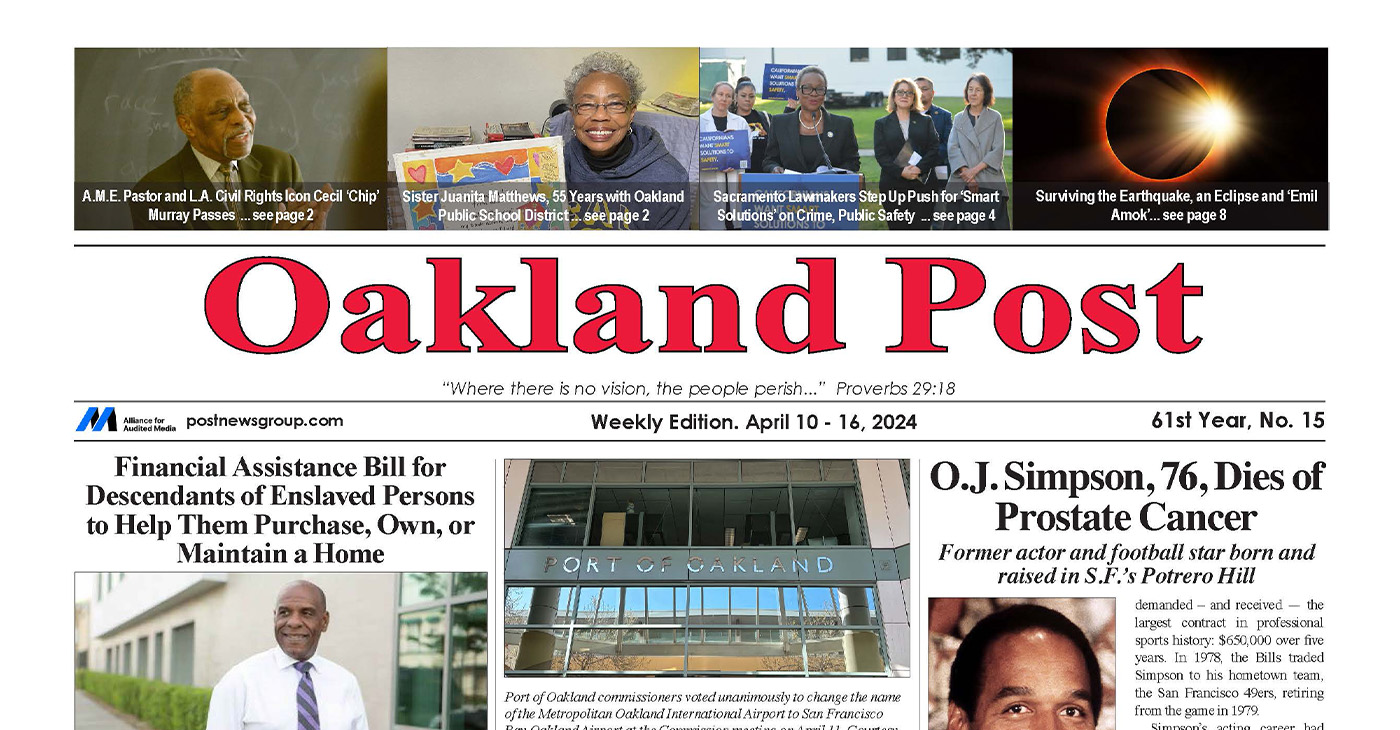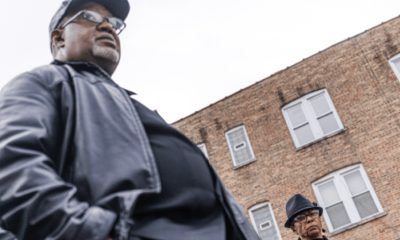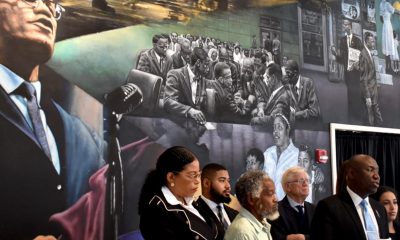Crime
Police often use broad exemption to keep videos from public
DEFENDER NEWS NETWORK — The video is brief but disturbing: An officer is seen hitting an unarmed suspect with his pistol as the man falls into the grass. An autopsy would later show that he died from a gunshot to the back of the head.
By Defender News Service
The video is brief but disturbing: An officer is seen hitting an unarmed suspect with his pistol as the man falls into the grass. An autopsy would later show that he died from a gunshot to the back of the head.
After the death last July of 26-year-old Daniel Fuller in Devils Lake, North Dakota, investigators described the video to his grieving relatives. But for days, weeks and then months, they refused to release it to the family or the public. They did so only after a prosecutor announced in November that the officer did not intend to fire his gun and would not face criminal charges.
“It took forever for them to release the video because they kept saying it was an ongoing investigation,” said Fuller’s older sister, Allyson Bartlett. “I don’t think they wanted pressure from the community.”
Her experience is typical. An investigation by The Associated Press has found that police departments routinely withhold video taken by body-worn and dashboard-mounted cameras that show officer-involved shootings and other uses of force. They often do so by citing a broad exemption to state open-records laws — by claiming that releasing the video would undermine an ongoing investigation.
During the last five years, taxpayers have spent hundreds of millions of dollars to outfit officers’ uniforms and vehicles with cameras and to store the footage they record as evidence. Body cameras, in particular, have been touted as a way to increase police transparency by allowing for a neutral view of whether an officer’s actions were justified. In reality, the videos can be withheld for months, years or even indefinitely, the AP review found.
To be sure, some departments voluntarily release videos of high-profile incidents, sometimes within days or weeks. They also are forced to share them during civil rights lawsuits or air them when suspects face trial. Many also routinely release videos that show officers in a positive light, such as when they rescue people from accidents, fires and other dangers. But how requests are handled when they are requested by citizens, reporters and government watchdogs varies widely.
The AP tested the public’s ability to access police video for Sunshine Week, an annual celebration of open government, by filing open records requests related to roughly 20 recent use-of-force incidents in a dozen states.
They were met with a series of denials and failed to unearth video of a single incident that had not already been released publicly. Some videos could be released in coming months or years once criminal and disciplinary investigations are concluded. By then, the public interest in knowing what happened may have waned significantly.
In rejecting or delaying the requests, most law enforcement agencies and prosecutors cited exemptions that allow them to keep records of pending investigations secret. One county claimed the exemption would allow it to keep the video of a motorist’s fatal shooting secret forever — even though the investigation has concluded and cleared the deputy involved.
Critics say the exemption is often misapplied to keep from public view video that might shine an unfavorable light on the actions of officers. The exemption is intended to protect sensitive details about investigations that might tip off suspects that they are under scrutiny or alert them to what evidence police have obtained. But when officers shoot or otherwise use force on suspects, they know their actions are the focus of the investigation and often have access to the videos of the incidents.
“It is for that reason that the investigative records exemption literally makes no sense and should have no place when it comes to police body camera footage. It is a square peg in a round hole,” said Chad Marlow, an expert on laws governing body cameras at the American Civil Liberties Union. “We didn’t know that would end up being the get-out-of-FOIA free card for police departments, but it has certainly turned into that.”
Authorities say they have good reason for withholding video during investigations, such as preventing the memories of witnesses from being tainted or sparking protests with an out-of-context snippet of a deadly encounter. But the problem, said former federal prosecutor Val Van Brocklin, is that “there is no national standard of when and how this stuff gets released.”
“It’s such a mish-mash, and that creates a problem with expectations,” she said.
___
In West Virginia, a prosecutor withheld a video that led to the firing of two state troopers for allegedly beating a 16-year-old suspect. In Georgia, a county sheriff’s office refused to release video of a 22-year-old man who allegedly shot himself to death while struggling with police, an explanation that has been questioned and sparked protests.
In Atlanta, where officers were recently criticized in an audit for failing to use their body cameras as intended, the department would not release video of an officer-involved shooting that happened last summer, saying the officer could potentially still face disciplinary action.
“I see it all over the nation that police departments use this catch-all of ‘ongoing investigation’ to basically throw up a stone wall in front of those that might like to find out the truth,” said attorney Jonny Hibbert, who is representing the family of an 18-year-old Atlanta man who was shot and killed by an off-duty officer after allegedly stealing his car. His request for any video of that incident was recently denied.
The department in Sugar Land, Texas, which recently released dramatic video of officers rescuing a woman from a lake, refused to divulge footage of a 2016 struggle in which a man alleges he was beaten and severely injured by officers. In Seagoville, Texas, the department would not release video showing an officer using a stun gun to subdue a teenager brandishing a toy gun, even though it had publicized the incident as a textbook example of officers showing restraint. The department denied access because AP didn’t know the name of the teen involved in the Oct. 4 incident. It said that piece of information must be provided to request police videos under Texas law.
In North Liberty, Iowa, a city lawyer responded to a request for video of a traffic stop by calling it a confidential investigative record — then demanded the AP not publish footage of the incident it had already obtained.
The city had fired a patrol supervisor for mishandling the stop, claiming he violated the rights of suspects in a road rage incident, failed to draw his weapon and made other procedural errors. The supervisor has filed a lawsuit contesting his firing, and his attorney provided the AP with footage that he says shows his client acted appropriately. The city released a redacted version of the video only after AP declined the city’s request.
In the aftermath of the 2014 shooting of Michael Brown in Ferguson, Missouri, and similar deaths of unarmed black men, police departments around the country faced public pressure to begin using body cameras. Rather than resist, said Marlow, the ACLU expert, they embraced cameras — but often only released videos that showed police in a positive light.
“The decisions about whether footage is being released or not is being dominated by the group that is supposed to be watched,” he said. “When that happens, police body cameras go from being a tool for transparency and accountability into a propaganda tool.”
It’s not that way everywhere.
California’s state capital, Sacramento, has been roiled by protests over police shootings of unarmed black men — most recently, after the district attorney and state attorney general declined to bring charges against two officers in the fatal shooting of Stephon Clark, who was found to be holding a cellphone after he was killed. Police video of that shooting helped fuel the protests.
The department is among the most transparent in releasing officer videos; city policy that predates the Clark shooting requires the police department to release footage within 30 days of a major incident or justify why it won’t. In some cases, the department has released footage within days.
“We hope to say that we’re leading the way in releasing it and being transparent,” said a department spokesman, Marcus Basquez. “That’s a big priority for us, to build that trust with our community, and we feel releasing body-worn camera footage is one way.”
A state law taking effect in July requires all state and local law enforcement agencies in California to make audio and video recordings of critical incidents publicly available after 45 days, unless it would hinder an investigation. If it withheld recordings longer than a year, a department would have to show “clear and convincing evidence” of that assertion.
___
Police videos are considered public records in nearly every state, but vague laws and exemptions often give police chiefs and prosecutors wide discretion to determine when to release them.
A few states have limited the release of footage by exempting police videos from open records laws or requiring court orders to obtain their release. Others have carved out privacy exemptions for videos that show private homes, hospitals or juveniles.
The New York City Police Department, the nation’s largest, stopped releasing body camera videos entirely last year after a police union successfully argued in court that they were confidential personnel records. But the department vowed last month to continue releasing video of officer-involved shootings after an appeals court ruled that the union’s argument “would defeat the purpose of the body-worn-camera program.”
Adam Marshall, a lawyer for the Reporters Committee for Freedom of the Press, in 2015 called police body camera videos the “Wild West of open records requests” because of the uncertainty surrounding how they would be handled. Today, he says a growing number of court cases and state laws have made for more certainty — that many requests will be denied or delayed.
“It’s disappointing,” he said. “Unfortunately, it does not reflect the type of transparency and openness that the public hoped would result from body cameras.”
This article is originally appeared Defender News Network.
Activism
Oakland Post: Week of April 17 – 23, 2024
The printed Weekly Edition of the Oakland Post: Week of April 17 – 23, 2024

To enlarge your view of this issue, use the slider, magnifying glass icon or full page icon in the lower right corner of the browser window. ![]()
California Black Media
Commentary: Finding the Right Balance — Addressing Organized Retail Theft While Upholding Civil Liberties
Organized retail theft is a significant issue that impacts both consumers and businesses. While it is crucial to address theft and protect businesses from losses, we should also be mindful of safeguarding individuals’ constitutional rights, particularly the right to due process. AB 1990 by Assemblymember Wendy Carrillo, also known as the STOP Act, raises concerns about the balance between addressing theft effectively and ensuring civil liberties are upheld.

By Assemblymember Tina McKinnor | Special to California Black Media Partners
Organized retail theft is a significant issue that impacts both consumers and businesses. While it is crucial to address theft and protect businesses from losses, we should also be mindful of safeguarding individuals’ constitutional rights, particularly the right to due process.
AB 1990 by Assemblymember Wendy Carrillo, also known as the STOP Act, raises concerns about the balance between addressing theft effectively and ensuring civil liberties are upheld. This bill allows law enforcement officers to make warrantless arrests for shoplifting offenses not witnessed by the officer, as long as there is reasonable cause to believe the individual committed the crime. This bill has a dangerous potential for overreach and infringes on civil liberties, particularly the right to due process.
While the stated intention behind the STOP Act is to combat organized retail theft and protect businesses, there are valid concerns that this bill is an overreach and that existing law works, if properly enforced by our partners in law enforcement. A petty theft involving property stolen valued at $950 or less may be charged as a felony or misdemeanor (called a wobbler) if the offender has the following prior convictions: 1) at least on prior petty or theft-related conviction for which a term of imprisonment was served, and 2) a prior conviction for a serious or violent offense, for any registerable sex offense, or for embezzlement from a dependent adult or anyone over the age of 65. A misdemeanor can result in a sentence of up to one year in jail, whereas a felon can mean incarceration for 16 months, two years or three years. Let’s look at shoplifting in California. It occurs when a suspect enters a store, while that establishment is open, intending to steal property worth less than $950. The crime is considered a misdemeanor, punishable by up to six months in the county jail.
Granting officers the authority to arrest individuals based on reasonable cause, without witnessing the crime firsthand, can lead to negative consequences and possible violations of individual rights. Probable cause is the legal standard by which police authorities have reason to obtain a warrant for the arrest of a suspected criminal and for the courts to issue a search warrant. A grand jury uses the probable cause standard to determine whether or not to issue a criminal indictment. The principle behind the probable cause standard is to limit the power of authorities to conduct unlawful search and seizure of a person or its property, and to promote formal, forensic procedures for gathering lawful evidence for the prosecution of the arrested criminal. Reasonable cause does not require any of this due process and only requires that an officer reasonably believes that a crime has been committed. It is essential to find a middle ground that effectively addresses organized retail theft without compromising the fundamental rights of individuals.
California’s current laws, including the use of witness statements and surveillance evidence are sufficient for addressing suspected shoplifting and organized retail theft. California Attorney General Rob Bonta recently prosecuted Michelle Mack, a suspected organized smash and grab ringleader who paid twelve women to travel around California and commit over $8 million in retail theft at 21 different stores. AG Bonta used California’s current laws to have the suspect arrested and brought to justice.
The State of California is also making significant investments to address retail theft. Just this past year California invested an additional $267 million to combat organized retail theft. It has been less than a year and our law enforcement partners should have the opportunity to address this recent spike in retail theft crime.
Los Angeles County recently applied for and received a grant for the State of California for $15.6 million dollars to address retail theft enforcement. LA District Attorney George Gascon also recently formed an organized retail task force that partners with LA County Sheriff’s Department, Glendale, Beverly Hills, Burbank, Torrance and Santa Monica Police Departments to integrate their response to retail theft across the region. These collaborative efforts, such as those seen in initiatives like the organized retail task force in LA County, demonstrate the importance of a united approach to tackling theft while maintaining a balance between enforcement and civil liberties.
As we move forward, it is essential for policymakers, law enforcement agencies, businesses and communities to work together in finding solutions that effectively address organized retail theft without encroaching on individual rights. Ongoing evaluation and a commitment to thoughtful consideration will be crucial in navigating this challenge and fostering a safe and prosperous environment for all. Balancing the scales of justice to protect businesses while upholding civil liberties demands a comprehensive and conscientious approach from all stakeholders involved.
I am confident we can find that balance.
About the Author
Assemblymember Tina McKinnor (D-Inglewood) represents the 61st District in Los Angeles County, which includes parts of the South Bay, Inglewood, Hawthorne and Lawndale.
Activism
Oakland Post: Week of April 10 – 16, 2024
The printed Weekly Edition of the Oakland Post: Week of April 10 – 16, 2024

To enlarge your view of this issue, use the slider, magnifying glass icon or full page icon in the lower right corner of the browser window. ![]()
-

 Activism4 weeks ago
Activism4 weeks agoOakland Post: Week of March 20 – 26, 2024
-

 #NNPA BlackPress3 weeks ago
#NNPA BlackPress3 weeks agoCOMMENTARY: D.C. Crime Bill Fails to Address Root Causes of Violence and Incarceration
-

 #NNPA BlackPress3 weeks ago
#NNPA BlackPress3 weeks agoMayor, City Council President React to May 31 Closing of Birmingham-Southern College
-

 #NNPA BlackPress3 weeks ago
#NNPA BlackPress3 weeks agoCOMMENTARY: Lady Day and The Lights!
-

 #NNPA BlackPress3 weeks ago
#NNPA BlackPress3 weeks agoFrom Raids to Revelations: The Dark Turn in Sean ‘Diddy’ Combs’ Saga
-

 #NNPA BlackPress3 weeks ago
#NNPA BlackPress3 weeks agoBaltimore Key Bridge Catastrophe: A City’s Heartbreak and a Nation’s Alarm
-

 #NNPA BlackPress3 weeks ago
#NNPA BlackPress3 weeks agoBaltimore’s Key Bridge Struck by Ship, Collapses into Water
-

 Activism3 weeks ago
Activism3 weeks agoOakland Post: Week of March 27 – April 2, 2024

















































